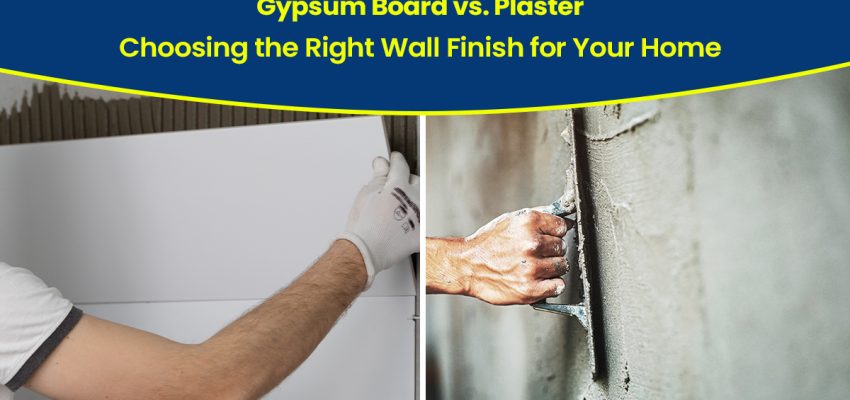When you’re building, you’ll have to choose between two main options for your walls: Gypsum Board and plaster. Both have their good and not-so-good points. In this blog, we’ll explain the advantages and disadvantages of each, how to distinguish between them and assist you in making the right choice.
Post your Requirement
What Is Plaster?
For a very long time, builders used plaster to make walls and ceilings inside houses. If you enter an old house built before 1950, you’ll probably see plaster on the walls and ceilings. People liked using plaster because it was strong and could cover different materials like brick, wood, and stone.
To make plaster, they would mix cement, sand, and water, and sometimes add things like granite, silicone, or gypsum. A professional would put this mix in layers on a surface made of plasterboard or lath, and then let it dry and stick to the surface. After it dried, they could sand it smooth and paint it to make it look how they wanted.
What Is a Gypsum Board?
Gypsum Board became popular in the mid-20th century as a substitute for plaster and is now commonly used worldwide. Drywall is made of gypsum plaster squeezed between two heavy paper layers. It can be easily cut to fit around doors, windows, and outlets. It’s great for keeping homes warm in cold places because it can have insulation behind it.
To put up a Gypsum Board, professionals use nails, screws, or special fasteners. They cover the nail and screw heads and the seams with tape and a flexible compound. Once it dries, you can paint or add another finishing layer to make it look nice.
Plaster vs.Gypsum Board: Detailed Comparison
Below we have done a detailed comparison between Plaster and Gypsum Board:
- Durability: Plaster stands out for its durability, as it’s dense and can last for decades without needing replacement. However, it’s harder to hang decor on plaster walls due to their solid nature. Gypsum Board, in contrast, is less durable and more prone to damage, but it is easier to hang items on, making it a suitable choice for those who frequently redecorate.
- Installation Time: If time is a critical factor, the gypsum board is the fastest option, as experienced crews can install it within a few days, making it suitable for projects on tight schedules. Plaster installation is a lengthier process, taking several weeks, including drying time, which may not be ideal for fast-paced projects.
- Soundproofing: Plaster excels in soundproofing, making it a superior choice for those needing to minimize sound transmission. Gypsum Board, however, allows sound to pass through more easily, but it can be improved by adding special acoustic materials behind the panels.
- Insulation: Gypsum Board offers an advantage when it comes to adding insulation, as it can be easily integrated with various insulation materials. Plaster, while being a better insulator on its own, poses challenges when retrofitting insulation into existing walls.
- Energy Efficiency: Gypsum Board, when combined with quality insulation, is more energy-efficient, reducing energy consumption for temperature control. Plaster, though not as energy-efficient, has the benefit of lasting longer and reducing construction waste.
- Repairs: Gypsum Board is generally easier to repair, with repair kits available for small to mid-sized damages. Plaster repairs can be more complex, often requiring professional help for significant damage or deep cracks.
- Fire Resistance: Plaster offers a higher level of fire resistance, particularly when combined with non-combustible materials, making it a preferable choice for fire protection.
- Look and Finish: Plaster can achieve a more polished look and is less prone to damage, offering a smoother and stucco-like finish, making it ideal for decorative purposes. Gypsum Board provides various design options, although achieving a perfectly smooth finish can be challenging.
- Hanging Decor: Hanging decor is more straightforward on the Gypsum Board. Plaster, being harder and more brittle, may lead to cracks or damage when installing hanging hardware, requiring greater care.
The choice between plaster and Gypsum Board depends on the specific needs of your project, your budget, and the desired features such as durability, soundproofing, or ease of installation.
Conclusion
So, which one’s better? Well, it depends on where you’re using it. For the outside of buildings, cement plaster is excellent. But for inside walls, gypsum plaster is often preferred. It dries quickly and is easy to work with. Gypsum plaster saves time and money because it doesn’t need water curing. It also dries fast, so you can start painting sooner. Plus, it looks nice, so you don’t need to spend extra time and money on smoothing it. Gypsum plaster is often chosen by builders because it’s cost-effective. On the other hand, cement plaster needs the right mix of sand and cement, and if it’s not perfect, the finish won’t be right. Gypsum plaster is also eco-friendly since it can be recycled. Although gypsum plaster is better in many ways, cement plaster wins for long-term durability. Hope our blog helped you in making an informed decision as per your specific needs.
FAQs
Q-1. What do you need to consider when choosing between plaster and drywall?
A-1. Consider factors like your project’s budget, desired finish, and specific needs. Plaster offers durability and soundproofing, while drywall is cost-effective and easier to install.
Q-2. Why is gypsum board used predominantly for walls rather than plaster?
A-2. Gypsum board (drywall) is preferred for walls due to its affordability, ease of installation, and adaptability for interior use. It allows for quicker construction and provides a smooth surface for finishing.
Q-3. Are plaster walls better than drywall?
A-3. Plaster walls offer durability and superior soundproofing but are more costly and time-consuming to install. The choice depends on your priorities and the project’s requirements.
Q-4. Is gypsum plaster good for walls?
A-4. Gypsum plaster is suitable for interior walls, as it dries quickly, offers a smooth finish, and is cost-effective. It’s a popular choice for many construction projects.


















Post A Comment